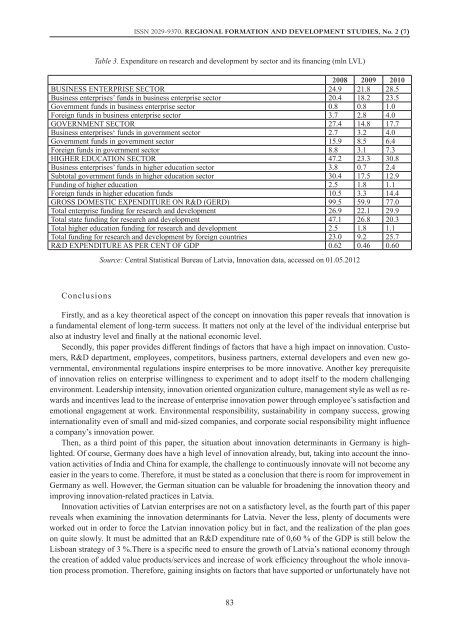regional formation and development studies - KlaipÄdos universitetas
regional formation and development studies - KlaipÄdos universitetas
regional formation and development studies - KlaipÄdos universitetas
You also want an ePaper? Increase the reach of your titles
YUMPU automatically turns print PDFs into web optimized ePapers that Google loves.
ISSN 2029-9370. Regional Formation <strong>and</strong> Development Studies, No. 2 (7)<br />
Table 3. Expenditure on research <strong>and</strong> <strong>development</strong> by sector <strong>and</strong> its financing (mln LVL)<br />
2008 2009 2010<br />
BUSINESS ENTERPRISE SECTOR 24.9 21.8 28.5<br />
Business enterprises’ funds in business enterprise sector 20.4 18.2 23.5<br />
Government funds in business enterprise sector 0.8 0.8 1.0<br />
Foreign funds in business enterprise sector 3.7 2.8 4.0<br />
GOVERNMENT SECTOR 27.4 14.8 17.7<br />
Business enterprises‘ funds in government sector 2.7 3.2 4.0<br />
Government funds in government sector 15.9 8.5 6.4<br />
Foreign funds in government sector 8.8 3.1 7.3<br />
HIGHER EDUCATION SECTOR 47.2 23.3 30.8<br />
Business enterprises’ funds in higher education sector 3.8 0.7 2.4<br />
Subtotal government funds in higher education sector 30.4 17.5 12.9<br />
Funding of higher education 2.5 1.8 1.1<br />
Foreign funds in higher education funds 10.5 3.3 14.4<br />
GROSS DOMESTIC EXPENDITURE ON R&D (GERD) 99.5 59.9 77.0<br />
Total enterprise funding for research <strong>and</strong> <strong>development</strong> 26.9 22.1 29.9<br />
Total state funding for research <strong>and</strong> <strong>development</strong> 47.1 26.8 20.3<br />
Total higher education funding for research <strong>and</strong> <strong>development</strong> 2.5 1.8 1.1<br />
Total funding for research <strong>and</strong> <strong>development</strong> by foreign countries 23.0 9.2 25.7<br />
R&D EXPENDITURE AS PER CENT OF GDP 0.62 0.46 0.60<br />
Source: Central Statistical Bureau of Latvia, Innovation data, accessed on 01.05.2012<br />
Conclusions<br />
Firstly, <strong>and</strong> as a key theoretical aspect of the concept on innovation this paper reveals that innovation is<br />
a fundamental element of long-term success. It matters not only at the level of the individual enterprise but<br />
also at industry level <strong>and</strong> finally at the national economic level.<br />
Secondly, this paper provides different findings of factors that have a high impact on innovation. Customers,<br />
R&D department, employees, competitors, business partners, external developers <strong>and</strong> even new governmental,<br />
environmental regulations inspire enterprises to be more innovative. Another key prerequisite<br />
of innovation relies on enterprise willingness to experiment <strong>and</strong> to adopt itself to the modern challenging<br />
environment. Leadership intensity, innovation oriented organization culture, management style as well as rewards<br />
<strong>and</strong> incentives lead to the increase of enterprise innovation power through employee’s satisfaction <strong>and</strong><br />
emotional engagement at work. Environmental responsibility, sustainability in company success, growing<br />
internationality even of small <strong>and</strong> mid-sized companies, <strong>and</strong> corporate social responsibility might influence<br />
a company’s innovation power.<br />
Then, as a third point of this paper, the situation about innovation determinants in Germany is highlighted.<br />
Of course, Germany does have a high level of innovation already, but, taking into account the innovation<br />
activities of India <strong>and</strong> China for example, the challenge to continuously innovate will not become any<br />
easier in the years to come. Therefore, it must be stated as a conclusion that there is room for improvement in<br />
Germany as well. However, the German situation can be valuable for broadening the innovation theory <strong>and</strong><br />
improving innovation-related practices in Latvia.<br />
Innovation activities of Latvian enterprises are not on a satisfactory level, as the fourth part of this paper<br />
reveals when examining the innovation determinants for Latvia. Never the less, plenty of documents were<br />
worked out in order to force the Latvian innovation policy but in fact, <strong>and</strong> the realization of the plan goes<br />
on quite slowly. It must be admitted that an R&D expenditure rate of 0,60 % of the GDP is still below the<br />
Lisboan strategy of 3 %.There is a specific need to ensure the growth of Latvia’s national economy through<br />
the creation of added value products/services <strong>and</strong> increase of work efficiency throughout the whole innovation<br />
process promotion. Therefore, gaining insights on factors that have supported or unfortunately have not<br />
83

















